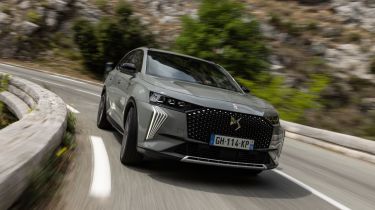DS 7 E-TENSE performance, top speed & engine
The DS 7 E-TENSE is a fast and comfortable long-distance cruiser, but it's not as impressive on a twisty backroad as some rivals
| Model | 0-62mph | Top speed | Driven wheels | Power |
|---|---|---|---|---|
| E-TENSE 225 | 8.9s | 140mph | Front | 222bhp |
| E-TENSE 4x4 300 | 5.9s | 149mph | Four | 296bhp |
| E-TENSE 4x4 360 | 5.6s | 148mph | Four | 355bhp |
All three versions of the DS 7 E-TENSE use a 1.6-litre turbocharged petrol engine and all have a decent amount of power. But it’s the dual-motor, four-wheel drive versions that provide the punchiest acceleration. We didn’t think the E-TENSE 4x4 300 model was lacking in power but, in the 2022 facelift, DS added a performance-focused range-topper with 355bhp. This version, badged the E-TENSE 4x4 360, shares its powertrain with the Peugeot 508 PSE and the top-of-the-range DS 9.
The presence of two electric motors (one on each axle) means there's a four-wheel-drive mode, which can be turned on and off as needed, although this isn't a genuine off-roader in the mould of a Land Rover Defender by any stretch.
DS 7 E-TENSE 0-62mph, top speed and acceleration
4x4 versions of the DS 7 are undeniably fast. The E-TENSE 300 hits 0-62mph in 5.9 seconds and the newly introduced E-TENSE 360 does the same in 5.6 seconds; both have a top speed approaching 150mph. Those numbers may well seem like overkill for a family SUV, but they do make sure the French contender isn't left behind by its premium Audi, BMW and Mercedes rivals.
They also mean it deals with a full load of passengers and luggage with ease, and will get up to speed on a motorway slip road, or overtake a slow-moving vehicle, very swiftly. The standard eight-speed automatic gearbox's shifts are smooth, if not the very fastest we've experienced.
A cheaper and less powerful (222bhp) front-wheel drive version of the plug-in hybrid DS 7 is also offered. Acceleration to 62mph takes 8.9 seconds, and it feels neither fast nor slow. But in similar fashion to the front-drive versions of the closely related Vauxhall Grandland X and Peugeot 3008 hybrids, it could turn out to be the more suitable option for many buyers.
Handling
Plug-in hybrids can sometimes suffer in this department due to the additional weight they carry compared to their purely diesel and petrol counterparts. That issue isn't entirely absent here, but the presence of heavy battery packs mounted low down in the E-TENSE does serve to improve the car's ride quality compared to the standard version, which can get too unsettled by bumpy roads.
Citroen's clever 'Active Scan Suspension' system – which surveys the road ahead with a camera and prepares the suspension to absorb what's coming up – is standard on the DS 7 E-TENSE. We found the technology doesn't work quite as well as claimed, with truly bumpy rural or urban roads tending to overwhelm it a bit; it's very effective on faster roads or motorways, though making this an excellent long-distance cruiser.
DS has perhaps realised that the suspension setup could be better, so the new 4x4 360 model features a new setup that trades a little of the comfort for more control. The difference it makes is surprising; you can notice far less wobble and it could even please keen drivers. It’s a shame, then, that only the range-topper gets this new setup; the cheaper versions could definitely benefit from it.
